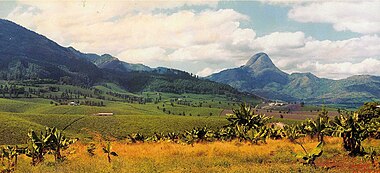Gurúè
| Gurúè | |
|---|---|

In the background: Mount Murresse; near the center, to the right: "Plantações Manuel Saraiva Junqueiro" - tea factory.
|
|
| Coordinates: 15°28′S 36°59′E / 15.467°S 36.983°ECoordinates: 15°28′S 36°59′E / 15.467°S 36.983°E | |
| Country |
|
| Provinces | Zambezia Province |
| Population | |
| • Total | 116,992 |
Gurúè (also spelt Gurué; known before independence as Vila Junqueiro) is a town located in the northern part of Mozambique, near the center of the province of Zambezia. It is the country's largest tea estate. Population as of the 1997 census was 99,325, but current estimates are 116 922.
The name Gurúè is said to be local tribal dialect (Lomwe) for "porco do mato" (peccary), or the name of a local tribal chief. Gurúè was founded and named by the Portuguese in the 19th century and developed as a major tea producing town starting in the 1930s. The Portuguese authorities promoted a thriving economic climate and local tea companies become major players in the industry.SDZ Cha, Chá Moçambique, Companhia da Zambézia, Chá Gurúè and Plantações Manuel Saraiva Junqueiro were the major tea companies headquartered in the town. With good natural attractions - Namuli mountain range (2419 m), large tea plantations (chá in Portuguese), and rivers, leading tea brands, such as Cha St Antonio, Cha Murrace, Chá Moçambique, Chá Licungo, Chá Gurúè, and Chá Montebranco Junqueiro, achieved international recognition – most of the production was exported to the United Kingdom, United States and Canada. Other agricultural activities were developed as well. In the 1940s, over 300 Portuguese lived in the small town of Gurúè which gravitated around the tea aristocracy who provided all the amenities for the entire working population, including a private small airline to the largest cities on the coast, like Nampula, and the port city of Quelimane, the capital of Zambezia, in Portuguese East Africa. After the death of tea tycoon Manuel Saraiva Junqueiro, in an airplane crash, the town of Gurúè was renamed Vila Junqueiro in October 1959. By the late 1950s the town had grown, the cinema was founded and TAZ airline (Transportes Aéreos da Zambézia) increased its flights in the town’s airfield. Under Portuguese administration the town expanded harmoniously in terms of urbanism and architectural landscape.
...
Wikipedia

